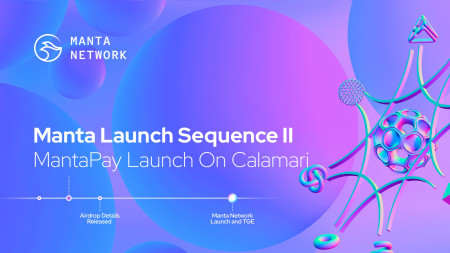MantaPay Launches on Calamari Network

SINGAPORE, March 16, 2023 (Newswire.com) - After the failure of big banks, people witnessed the limitations of trust with the existing financial system. Now more than ever marks an important time to empower users to store and access their funds in a non-custodial and private manner through web3. Therefore, Manta Network is excited to make this impact through the launch of MantaPay on Calamari.
After years of building and testing, rounds of community feedback reviews, and updates on cryptographic optimization and frontend design, the product is ready to release to the web3 world, starting within the Kusama ecosystem. Manta witnessed over 150,000+ private transactions take place on the testnet, and thousands of pieces of valuable feedback were provided to help improve the MantaPay product before its launch. To celebrate this launch, Manta will announce a series of early user opportunities, activities, airdrops, and other incentivized programs that will help drive the adoption of on-chain privacy.
To get started with MantaPay, two tools are required:
- The Manta Signer. It's a desktop application that protects spending secrets and builds zero-knowledge proofs (ZKP). It allows users to send and receive private assets, aka zkAssets. In the future, MantaPay is releasing an extension wallet application that will have Manta Signer natively integrated.
- A wallet application such as Polkadot.js, SubWallet or Talisman. This wallet application allows users to store public assets and transfer them to become zkAssets on MantaPay.
Once ready, head over to the MantaPay app and follow the instructions here.
MantaPay supports various cryptoassets on its private payment system:
- Calamari Token (KMA)
- Kusama Token (KSM)
- Karura Token (KAR)
- Moonriver Token (MOVR)
- More cryptoassets will be added
In a proactive stance to address regulatory ambiguity, MantaPay doesn't support users within specific regions, including the U.S., China, Iran, Cuba, North Korea, Syria, Myanmar (Burma), the regions of Crimea, Donetsk or Luhansk. Only users in certain jurisdictions can access the application.
Why MantaPay
MantaPay uses ZKP to guarantee that transfers are carried out in accordance with a structured protocol called "circuit" while maintaining the privacy of sensitive data.
The sensitive information acts as a witness in a ZKP system rather than publishing directly on-chain, ensuring the protocol is maintained correctly and no private data is leaked. The ledger then tests the resulting ZKP's verify function against the inputs from the public and, if it succeeds, publishes the transaction. MantaPay has optimized this entire process for the ZK circuit generation and verification.
MantaPay leverages the Poseidon hash to deliver the fastest prover speed of any layer one network, allowing users to generate a ZKP in around 2 seconds. The protocol uses a bring-your-own-token model, which allows privatization of various fungible and non-fungible tokens. It provides a permanent and reusable private address system, zkAddresses, to provide users with the convenience of a wallet interface and privacy through ZKP.
About Manta Network
Manta Network is the zk layer 1 blockchain with the fastest prover speed and most decentralized trusted setup that brings programmable privacy to web3. Its suite of core products and technologies, including zkNFTs and MantaPay, offers user-friendly access to powerful ZK-enabled use cases. The project is created by a team of experienced founders from prestigious institutions, including Harvard, MIT, and Algorand. The team began its research on Zero Knowledge Proof in 2019 during a cross-border payment research project under the MIT Digital Currency Initiative with the Monetary Authority of Singapore. Manta Network has received investments from many of the top web3 investment funds, including Binance Labs and Polychain Capital. It has grown through participation in the best web3 accelerators, including Alliance DAO and Berkeley Blockchain Xcelerator. Manta Network is poised to bring the next generation of web3 users and usher in a new chapter of privacy-focused web3 applications.
Source: Manta Network
